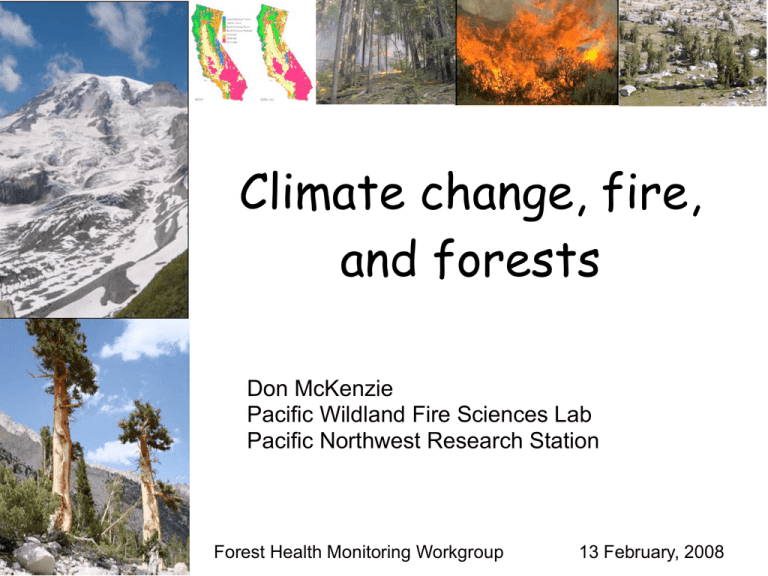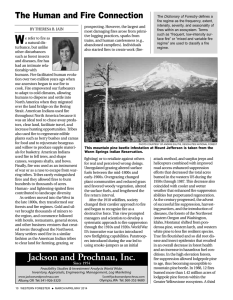Document 11894848
advertisement

http://www.yakima.net/ Climate change, fire, and forests UW Climate Impacts Group Don McKenzie Pacific Wildland Fire Sciences Lab Pacific Northwest Research Station Forest Health Monitoring Workgroup UW Climate Impacts Group 13 February, 2008 Hypotheses about ecosystem change in the West •Increasing moisture limits on productivity will alter (tree and other) species composition by • locally favoring more xeric species. • exacerbating episodes of vegetation dieback. • altering mortality and turnover rates. • Underlying ecological mechanism = large-scale shift to a negative water balance. •Disturbance will be the principal agent of ecosystem change • late 20th-century trends such as increasing insect mortality or fire area burned may be replaced by more abrupt changes. • underlying mechanisms here are complex, operate at multiple scales, and may be constrained by physical limits. Western Mountain Initiative (WMI) 2006 Fire Disturbance synergy Climate Vegetation Disturbance drives ecosystem changes 25-100 yr Climatic change New fire regimes More frequent fire More extreme events Greater area burned Species responses Fire-sensitive species Annuals & weedy species Specialists with restricted ranges Deciduous and sprouting species 100-500 yr Habitat changes Broad-scale homogeneity Truncated succession Loss of forest cover Loss of refugia Fire-adapted species Climate and fire area burned, 1977-2003: an ecologically based study in the American West • Generalized linear models to scale area-burned statistics to ecoprovinces. • Predictive models of fire area burned based on climatology. • Potential for ecologically meaningful future projections. Littell et al. (2008) Northern mountain pattern Current climate variables are the key predictors. Arid ecosystem (Southwest) pattern • Previous winter’s precipitation is a key predictor. • Current climate is less important. Climate, vegetation, and fuels Fuel moisture associated with current climate is the limiting factor. Fuel abundance and continuity associated with previous climate is the limiting factor. Northern mountain provinces, regional fire episodes, and climatic change MODIS • As temperature increases, the atmosphere evaporates more water from the landscape and plant tissues. • This produces larger than normal areas of depleted fuel moisture during the fire season. • Regional synchronization of fires occurs. Northern Rockies, July 2003 Arid Southwestern provinces, regional fire synchrony, and climatic change • Increasingly severe and prolonged droughts are expected. • But interannual cycles, e.g., ENSO, can maintain the pattern of fuel continuity. • Invasives like cheatgrass and buffelgrass could change everything. Stress complexes: synergistic effects on ecosystems McKenzie, D., D.L. Peterson, & J.S. Littell. In press. Global warming and stress complexes in forests of western North America. In “Forest Fires and Air Pollution Issues”, eds. A. Bytnerowicz, M. Arbaugh, C. Andersen, & A. Riebau. Elsevier Science, Ltd. Lodgepole pine Extended warm period, insects, pines die, fuels accumulate, sets up for large fires. Vulnerable age classes. Interior lodgepole pine Global warming Higher temperatures & more severe and extended droughts Bark beetles and defoliators Stand-replacing fire regime Extensive mature cohorts (70-80 yrs) Lodgepole pine mortality Large severe fires Fuel accumulation Salvage logging Changes in species composition (including exotics) Boreal black spruce Stand-replacing fire Stand-replacing beetles Stand replacing fire + global warming Black spruce Ecosystem change Paper birch Stand replacing insect kill + global warming White spruce Alaska Global warming Interior forests on permafrost soils Ice-rich lowlands (deciduous forests) Southcentral forests (nonmaritime)/Interior forests on permafrost-free soils Upland coniferous forests Higher temperatures Permafrost degradation More stand-replacing fires Thermokarst ponds Beetles Fuel accumulation Large fires Species conversion Wetlands, fens, and bogs ? Coniferous and deciduous forest More deciduous forest Summary • Projected climate changes favor increased fire extent and severity. The West will continue warming through the 21st century even if greenhouse gas emissions were stopped today. Fire regimes may change in unexpected ways. • Regional-scale and “landscape-scale” patterns will differ. Other disturbances, land use and management, and invasives will make a difference. • Generic management recommendation. Anticipate disturbance regimes and landscape patterns associated with future climate.








